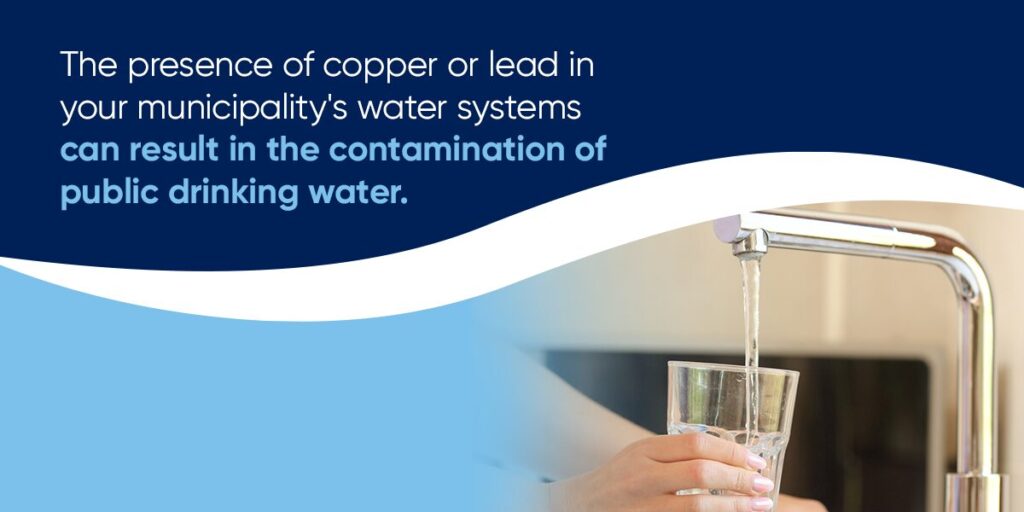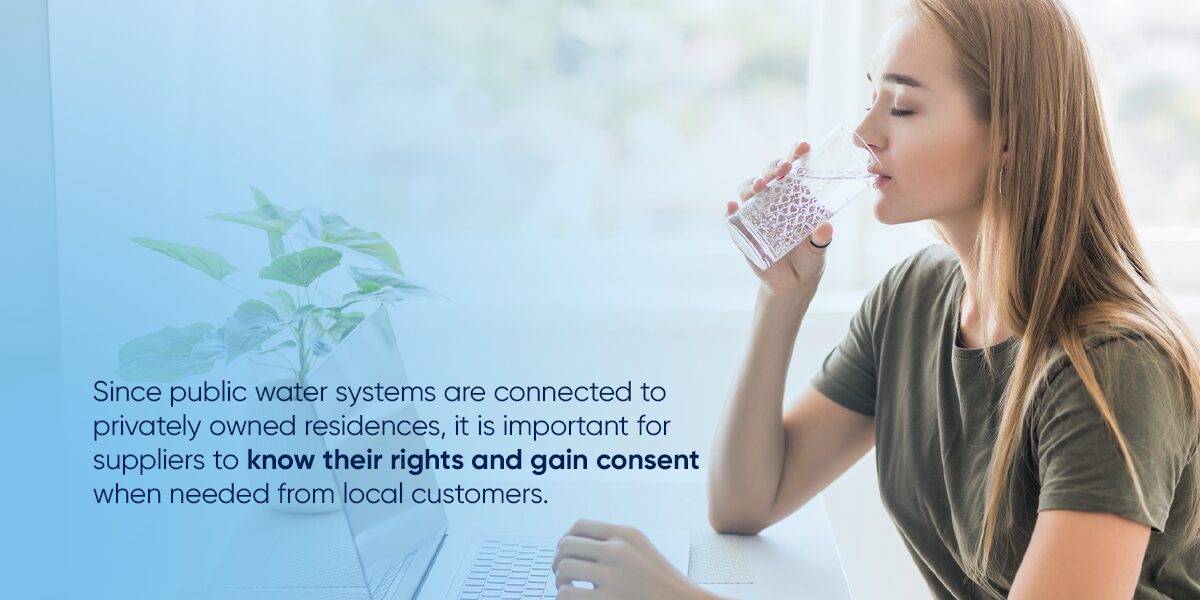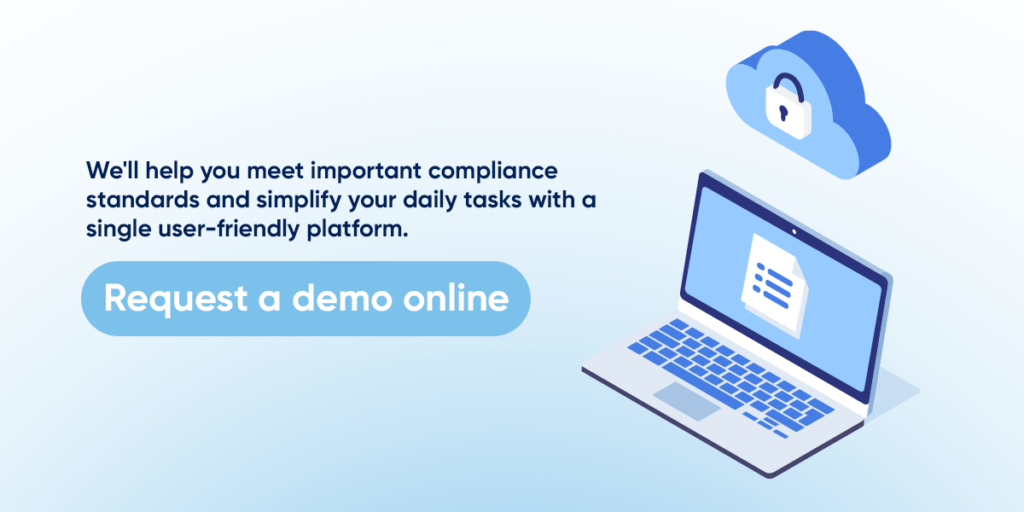
Lead and Copper Rule
Public water systems (PWS) must understand the Lead and Copper Rule (LCR) and how to comply with its regulations to ensure they are delivering safe, healthy drinking water to their communities. As a water supplier, it is your responsibility to stay informed and make the necessary upgrades by the mandated due dates.
We are breaking down what you need to know about the Lead and Copper Rule, and ways to make compliance easier on your operations.
An Overview of the EPA Lead and Copper Rule 2024
The Lead and Copper Rule is a United States federal regulation first issued in 1991 by the Environmental Protection Agency (EPA). Lawmakers published the rule after learning more about the adverse effects that lead and copper can have on human health, particularly for pregnant mothers, infants and young children.
Scientific studies have linked lead exposure to lowered IQ and compromised brain health. On the other hand, exposure to high levels of copper can cause:
- Nausea
- Stomach cramps
- Vomiting
- Diarrhea
The presence of copper or lead in your municipality’s water systems — including residential plumbing lines — can result in the contamination of public drinking water. The EPA aims to limit metal levels by identifying their source and replacing problematic plumbing materials.

LCR in Pennsylvania
The Pennsylvania Department of Environmental Protection (DEP) enforces the regulations, including the Lead and Copper Rule, set forth by the EPA.
The DEP works with public water providers throughout the state to ensure waterlines comply with maximum contaminant levels through the following:
- Ongoing monitoring
- Testing and reporting
- Corrective action
Lead and Copper Rule Revisions
In January 2021, the EPA published an updated version of these regulations titled the Lead and Copper Rule Revisions (LCRR). The changes required all water systems, including community and noncommunity, to submit an inventory of their service line materials to the Pennsylvania DEP. The LCRR compliance date for all water providers is October 16, 2024.
The revisions aim to support more comprehensive service line replacement to ultimately eliminate the presence of lead and copper in American drinking water. Additional changes in the updated version include:
- Improved, science-backed testing protocols.
- Trigger levels for beginning mitigation projects.
- Mandatory testing in childcare facilities and schools.
- Sharing lead service line locations with the public.
Lead and Copper Rule Improvements
In November 2023, the EPA announced its intention to share another update to the LCR, called the Lead and Copper Rule Improvements (LCRI).
The LCRI includes proposals to completely replace lead pipes within 10 years, improve the tap sampling process and identify all service lines with unknown materials. Water suppliers must familiarize themselves with these potential changes to ensure they stay compliant.
Lead and Copper Rule Compliance
Below are essential compliance standards local governments and municipal authorities must meet under the Lead and Copper Rule:
Service Line Inventory
Under the LCR, the initial responsibility of all water suppliers is to establish a comprehensive lead service line inventory. They must thoroughly review the historical records of their systems to identify the material of each line.
The purpose of creating your service line inventory is to more easily identify and track the materials used throughout your water system, helping you locate potentially problematic plumbing materials and ultimately begin creating a plan for replacement.
Water suppliers must include the classification of each line according to the material in their inventory. The classifications include the following:
- Lead
- Non-lead
- Lead status unknown
- Galvanized requiring replacement (GRR)
It is important to make note of every water line, despite whether or not it is actively in use. You’ll also need to include material classifications for customer-side service lines, where ownership is divided between the municipality and the homeowner. Each service line also requires a unique location identifier, such as a street address or notable landmark. The more detailed these identifiers are, the better.
The EPA also recommends including sub-classifications for your service line materials and an inventory of other components in your drinking water infrastructure that could potentially contain lead. Water suppliers must make their service line inventory readily available to the public, and they are due to the DEP by October 16, 2024.
Lead and Copper Tap Sampling and Monitoring
The tap sampling plan will outline the materials in your water distribution systems and highlight your sample sites.
Whether or not they are community or nontransient noncommunity water service lines, you must collect tap water samples from any systems that meet at least one of the criteria outlined below:
- Lead pipes
- Lead service lines
- Copper pipes with lead solders installed after 1982
The following are important lead and copper sampling instructions:
- Collect samples from a tap that has been off for at least six hours to ensure stagnant water conditions.
- Samples should come from a kitchen or bathroom cold-water faucet that is not attached to a water softener or point-of-use filter.
- Fill a sample bottle with 1,000 milliliters of water, tightly put the cap on and label the sample.
Water suppliers must work with a DEP-accredited lab when testing tap water for lead or copper.
Consumer Confidence Reports
As part of the EPA’s efforts to enhance public education and awareness about lead and copper in public water systems, all water suppliers must create and deliver an annual water quality report, also known as a Consumer Confidence Report. You need to share these insights with the DEP and all customers.
The report should include the test results from your collected water samples throughout the year, in addition to:
- Identifying the source of local drinking water, such as a lake or river.
- Highlighting the local risk of contamination.
- Listing regulated contaminants found in the drinking water.
The EPA mandates that all water suppliers must share their reports by July 1 annually.
Service Line Replacement
According to the EPA, there are currently about 9.2 million water service lines containing lead. The government’s goal is to replace all of these lines, completely rather than partially, in hopes of eliminating any potential for lead in our nation’s drinking water.
The plumbing elements that are most likely to contain lead include pipes, fixtures and faucets. Lead service lines that connect a home to the water main are often the biggest source of lead in local waterways. By replacing the source, water suppliers can effectively reduce lead exposure in their community.
An essential consideration for service line replacement projects is the risk of elevated lead levels in drinking water for a short period after the replacement. Communicating and engaging with your customers is integral to keeping them in the know about efforts to improve their drinking water and minimize harm.
Before the service line replacement, ensure you share the potential health effects of lead and copper exposure and let them know about temporary spikes in lead levels following the replacement project. Include information and instructions for removing, cleaning and re-installing faucet aerators as well as flushing service lines.
Water providers should also provide customers with the following during service line replacement efforts:
- A National Sanitation Foundation (NSF) and American National Standards Institute (ANSI) 53-certified pitcher filter or point-of-use device.
- Replacement cartridges for six months.
- Instructions for using and replacing the filters.
Under the proposed Lead and Copper Rule Improvements, water suppliers may also have to establish a public service line replacement plan to share with the community.
LCR Violations and Penalties
If a public water system violates or fails to comply with the LCR, regulatory agencies like the DEP or EPA can enforce a range of different penalties, such as fines, injunctions and orders.
Water suppliers that are not meeting the Lead and Copper Rule requirements may receive compliance orders that outline the specific next steps that the PWS must take to adhere to regulation and avoid further penalties or legal action.
Another consequence of not abiding by the LCR is loss of funding. The Environmental Protection Agency can withhold certain loans and grants to suppliers that fail to adequately meet regulations.
When consumers learn about LCR violations, it hurts your PWS’s reputation and credibility, which can impact your operations for years to come. Non-compliance can also result in serious legal action and lawsuits from your community members or advocacy groups looking to improve drinking water quality.
Common Lead and Copper Rule Challenges for Water Suppliers

As a water supplier, you have a serious responsibility to ensure your community’s public drinking water is as healthy and safe as possible while also meeting all applicable regulations from the state and federal government. Some of the common challenges and hurdles you may face while creating your service line inventory, sampling tap water and replacing lead lines include:
Educating and Engaging the Public
One obstacle you may face when addressing LCR regulations, inspections, water sampling and service line replacement is public engagement. As a water provider, you must keep your community informed about important health-related updates regarding their drinking water. You must balance being informative and supportive. Your customers should trust your services and understand why removing lead pipes and components will benefit their health.
Education is an essential part of getting your customers to work with you and comply with relevant tasks like sampling their tap water.
Customer Consent, Ownership and Access
Since public water systems are connected to privately owned residences, it is important for suppliers to know their rights and gain consent when needed from local customers.

Public water systems often have access to private property for conducting inspections, monitoring and some maintenance activities. However, there are some cases when access rights create hurdles for water suppliers looking to replace lead service lines. This is why education, engagement and connecting with your customers is essential — you may need voluntary consent to complete your work and comply with the LCR.
Funding Service Line Replacement
Implementing the necessary measures to comply with the Lead and Copper Rule can be costly for public water systems, especially those with limited funding and resources.
Getting financial assistance for service line replacement projects can be a challenge for many local municipalities. If the proposed LCRI passes, suppliers will have to ensure they have adequate funding to replace lead-containing systems within 10 years.
Time-Consuming Data Entry
Reporting for the LCR is another common challenge for suppliers. The process can take hours of your team’s valuable time. Using antiquated spreadsheets and manual data entry practices for creating your service line inventory and other applicable reports can be inefficient and lead to inaccuracies.
Instead, water suppliers should prioritize using updated solutions that will streamline data entry and help them manage their service line insights in a clear, easy-to-navigate format. Automated tools and software can completely streamline and enhance your reporting efforts.
LCR Resources and Service Line Inventory Templates
The Pennsylvania Department of Environmental Protection and EPA offers a few different resources to help water suppliers meet Lead and Copy Rule regulations and manage ongoing efforts to improve drinking water quality.
In August 2022, the EPA shared a helpful resource with public water systems called the Guidance for Developing and Maintaining a Service Line Inventory. This document offers recommendations for developing and maintaining your service line documentation. It features a thorough breakdown of everything you need to know about creating inventories and providing the right information when reporting to EPA. The guide will help you navigate the entire process and ensure that you meet all necessary requirements for October 16, 2024.
You can find helpful, updated service line inventory templates on the DEP’s website. They include Excel spreadsheet templates for your inventory information. However, water suppliers can benefit from using more advanced electronic databases for these efforts. If you have an existing database with your service line details, creating your reports will be significantly easier and more efficient.
How Muni-Link Software Can Help
If you’re looking to streamline data management and save valuable time bringing your public water systems into compliance with the Lead and Copper Rule, Muni-Link’s cloud-based software is here for you. With our sewer and water utility billing system, you can access and manage customer information in an easy-to-use system.
Muni-Link simplifies your utility billing, so your team does not have to dedicate hours to manual data entry, bill generation or meter readings. The software uses automation and advanced features that do the work for you, allowing your team to focus on more important tasks, like customer outreach and service line inventory efforts.
Our software streamlines reporting and eliminates the time spent plugging in data points for dozens of columns on a spreadsheet. With WebPresence from Muni-Link, you can completely revolutionize customer communication with a solution designed specifically for local municipalities. We’ll help you ultimately manage and enhance your daily operations while making connecting with your customers a breeze.
Request a Demo of Muni-Link to Get Started Today
Muni-Link helps local government and municipal authorities streamline utility billing operations with specialized software. We understand the importance of accurate and efficient utility bill management. Our solutions help you provide simplified billing processes and better customer service to your residents.
Muni-Link software is cloud-based, so you automatically get the latest encryptions and developments to optimize data security. We’ll help you meet important compliance standards and simplify your daily tasks with a single user-friendly platform.
Are you interested in learning more? Request a demo online to connect with a Muni-Link representative today!
